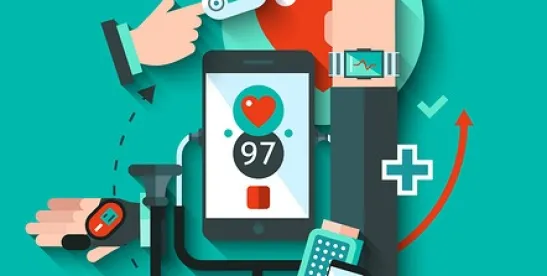On 1 May, 2018 the Centre for Policy Studies (the “CPS”) published its latest paper on the UK’s National Health Service (the “NHS”) entitled “Powerful Patients, Paperless Systems: How New Technology Can Renew The NHS” (the “Paper”). The Paper advocates a “digital first NHS” that adopts a paperless system and enables patients to take full advantage of the continuing digitisation and integration of technology, often referred to as the Fourth Industrial Revolution (“4IR”).
To facilitate this change the Paper outlines three key targets that should be set by the Department of Health and Social Care, to be achieved by 2028:
- Move the NHS to a “digital first” platform and to aim to ensure that all interactions within the health service are digitally driven.
- Build an ecosystem of apps and innovation within and around the NHS, to improve patient service and control.
- Ensure that the savings made from automation and innovation are put back into frontline services and that budgets for staff R&D and technology training rise in line with overall NHS spending.
The Paper makes 10 key recommendations to help achieve these goals:
1. All NHS Patient Records to be Fully Digitised
- Medical records will be fully digitised and portable so as to be easily shared between General Practitioners, hospitals, NHS Trusts and other care providers.
- Change should occur at all levels of NHS healthcare, with the Government providing financial incentives and sanctions for non-compliance.
- Patients will be able to opt out of digitization.
2. New Digital Messaging System for all NHS Doctors and Nurses
- Introduction of a unified, data compliant, digital messaging system accessible by phone and tablet.
- The system will allow for secure and effective communication between healthcare and hospitals alongside doctors and nurses.
- Avoid health workers endangering patient confidentiality by communicating through other, generally available, messaging apps.
3. Build on the new NHS App to Provide Patients with Instant Access to Medical Data and Health Services
- Introduction of a single portal and app where patients can access their health records, manage medications, control access to data and seek medical advice.
- Avoid the confusion caused to some patients by the availability of multiple, overlapping, NHS apps.
- Doctors and nurses to use the app to manage a range of issues including ensuring that medication is correctly administered and meeting waiting time targets.
- App to use an open source platform that would allow developers in the private sector to enhance the service.
4. A NHS Kitemark for Approved Apps
- Introduction of a new certification standard through the use of an NHS Kitemark logo.
- The Kitemark will indicate to patients and users that the associated app is safe to use, or NHS approved.
- This approach will also allow small app developers to “credibly market their products to the wider NHS market”.
5. Regional Data Innovation Hubs to Cover the Whole Population of England
- New regional data innovation hubs will allow anonymised patient data to be shared for the purposes of care and research as well as helping to make the NHS more efficient
- Patients will be in control of their data, although, unless they explicitly opt out, patients are deemed to have given their consent for their medical records to be shared anonymously for data research.
6. A Hub and Spoke Model of Digital Specialisation – so 4IR Technologies Become Available to All
- Digital hub and spoke model should be adopted as new technologies are used to help NHS hospitals and trusts become “world class in a smaller number of fields”.
- The proposed model aims to mitigate the initial expense of 4IR technology, such as those for surgery and personalised medicine.
- The proposed model aims to maximise coverage of this technology around the country.
7. Technology Retraining Scheme for Doctors and Nurses – Continuing Professional Development for the 4IR
- Savings made from automation will provide money to be set aside to provide training to help doctors and nurses develop the skills to manage the new 4IR technologies.
- Money to also be made available to help clinicians whose work may be replaced by automation.
8. Guarantee that every Pound Saved from Back Office Automation is Re-Invested in Frontline Services
- Money saved from the implementation of automation and AI will be routed to frontline health service priorities.
- Automation will help alleviate “labour-intensive back office tasks” and aid those working on the frontline.
9. More Investment into R&D as NHS Budgets Increase – To Speed up Adoption of New Technologies
- Money to be allocated for R&D and helping to spread new technology should be tied to the overall NHS budget so as to increase at the same rate.
- A focus on R&D should help to foster a “pro-innovation” culture at all levels of the NHS.
10. Launch NHS Worldwide – A New NHS Commercial Arm to Replace Healthcare UK
- Healthcare UK will become NHS Worldwide and sell healthcare techniques, smartphone apps, robotic surgery or medicines around the world.
- NHS Worldwide will have the power to invest in new technology, with all profits going back into the NHS for the benefit of patients.
- The body will also be used to deploy money “to spread British healthcare innovation into developing countries.”
Jonathan Benjamin contributed to this post.




 />i
/>i

